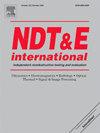Advanced detection and reconstruction of welding defects in irregular geometries using eddy current pulsed thermography
IF 4.1
2区 材料科学
Q1 MATERIALS SCIENCE, CHARACTERIZATION & TESTING
引用次数: 0
Abstract
The global pursuit of net-zero goals has accelerated the growth of solar energy, positioning photovoltaic (P.V.) systems at the forefront of renewable energy due to their efficient and sustainable electricity conversion. Detecting and classifying welding defects in P.V. systems—especially those with intricate surfaces and varying defect scales—is critical yet complex, as irregular geometries challenge traditional nondestructive testing (NDT) methods. To address this, we present an advanced framework integrating Graph Signal Processing (GSP) into Eddy Current Pulsed Thermography (ECPT). In this method, temporal thermographic sequences are mapped onto a graph topology, where nodes correspond to discrete time points and edges encode temporal dependencies through an adjacency matrix. The graph Laplacian operator, constructed based on the temporal adjacency relationships, is eigen-decomposed to project thermal response dynamics into the graph spectral domain. This transformation enables frequency-resolved analysis of time-evolving thermal waves, inherently isolating defect-induced transient signatures from steady-state thermal backgrounds. In our experimental study, Helmholtz coils generate a uniform current density combined with the novel framework, facilitating effective inspection of intricate surfaces by integrating 3D surface measurements with 3D thermography. Furthermore, we compare this method with other state-of-art algorithms. This multidimensional feature analysis framework robustly separates defect profiles from their backgrounds, addressing the unique challenges posed by the irregular geometries in P.V. systems.
利用涡流脉冲热成像技术检测和重建不规则几何形状的焊接缺陷
全球对净零目标的追求加速了太阳能的发展,光伏(pv)系统因其高效和可持续的电力转换而处于可再生能源的前沿。由于不规则的几何形状对传统的无损检测(NDT)方法提出了挑战,因此检测和分类P.V.系统中的焊接缺陷(特别是那些具有复杂表面和不同缺陷规模的焊接缺陷)是关键而复杂的。为了解决这个问题,我们提出了一个将图形信号处理(GSP)集成到涡流脉冲热成像(ECPT)中的高级框架。在该方法中,时间热成像序列被映射到图拓扑上,其中节点对应于离散时间点,边缘通过邻接矩阵编码时间依赖性。基于时间邻接关系构造的图拉普拉斯算子进行特征分解,将热响应动力学投影到图谱域。这种转换可以对随时间变化的热波进行频率分辨分析,固有地将缺陷引起的瞬态特征与稳态热背景隔离开来。在我们的实验研究中,亥姆霍兹线圈结合新框架产生均匀的电流密度,通过将3D表面测量与3D热成像相结合,促进了复杂表面的有效检测。此外,我们将该方法与其他最先进的算法进行了比较。这种多维特征分析框架有力地将缺陷轮廓与其背景分离开来,解决了P.V.系统中不规则几何形状所带来的独特挑战。
本文章由计算机程序翻译,如有差异,请以英文原文为准。
求助全文
约1分钟内获得全文
求助全文
来源期刊

Ndt & E International
工程技术-材料科学:表征与测试
CiteScore
7.20
自引率
9.50%
发文量
121
审稿时长
55 days
期刊介绍:
NDT&E international publishes peer-reviewed results of original research and development in all categories of the fields of nondestructive testing and evaluation including ultrasonics, electromagnetics, radiography, optical and thermal methods. In addition to traditional NDE topics, the emerging technology area of inspection of civil structures and materials is also emphasized. The journal publishes original papers on research and development of new inspection techniques and methods, as well as on novel and innovative applications of established methods. Papers on NDE sensors and their applications both for inspection and process control, as well as papers describing novel NDE systems for structural health monitoring and their performance in industrial settings are also considered. Other regular features include international news, new equipment and a calendar of forthcoming worldwide meetings. This journal is listed in Current Contents.
 求助内容:
求助内容: 应助结果提醒方式:
应助结果提醒方式:


